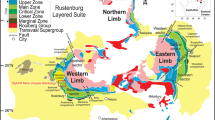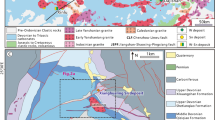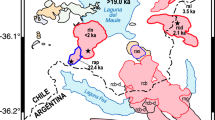Abstract
The origin of micrographic granites (formerly called Masanites) in the southern Kyongsang Basin is discussed on the basis of the petrological, mineralogical, and geochemical characteristics along with comparisons with experimental references. The micrographic granite in the Masan area occurs as several dikes of minor quantity in a hornblende-biotite granite, whereas those in the Kimhae and Busan areas are gradational to the porphyritic biotite (±hornblende) granites, forming discrete stocks together with the accompanying granites. Geochemical properties of the micrographic granites are largely dependent upon those of the accompanying granites. This suggests that the individual micrographic granites are not independent intrusive bodies. The most important factor for the formation of micrographic intergrowths was probably the degree of undercooling during the decompression under a kinetically driven, nonequilibrium condition. The micrographic intergrowth of quartz was probably formed at moderate degree (at least 100°C) of undercooling from a H2O-saturated magma emplaced into the shallow crustal levels. Common occurrence of miarolitic cavities in the micrographic granites indicates that vapor exsolution would enhance the degree of undercooling of the melt. Chemical compositions of magmas were another important factor for controlling the sequence of liquidus phases. Quartz should have higher liquidus temperature than alkali feldspar under the condition of moderate degree of undercooling. The bulk composition of magmas might not correspond to the eutectic composition, so as to form micrographic intergrowths, given the fact that the composition of the Kimhae micrographic granite is incompatible with any known eutectic one. The spatial distribution of the micrographic granites was largely controlled by penecontemporaneous faults and/or fractures. This suggests that the micrographic intergrowths were formed in specific parts within a pluton where decompression as well as vapor exsolution was rapid enough to result in moderate degree of undercooling.
Similar content being viewed by others
References
Barker, D.S., 1970, Compositions of granophyre, myrmekite and graphic granite. Geological Society of America Bulletin, 81, 3339–3350.
Buddington, A.F., 1959, Granite emplacement with special reference to North America. Geological Society of America Bulletin, 70, 671–747.
Buddington, A.F. and Lindsley, D.H., 1964, Iron-titanium oxide minerals and synthetic equivalents. Journal of Petrology, 5, 310–357.
Burnham, C.W., 1979, Magmas and hydrothermal fluids. In: Barnes, H.L. (ed.), Geochemistry of Hydrothermal Ore Deposits (2nd edn.). John Wiley, New York, p. 71–136.
Candela, P.A., 1997, A review of shallow, ore-related granites: textures, volatiles, and ore metals. Journal of Petrology, 38, 1619–1633.
Chorlton, L.B. and Martin, R.F., 1978, The effect of boron on the granite solidus. Canadian Mineralogist, 16, 239–244.
Coleman, R.G., DeBari, S. and Peterman, G., 1992, A-type granite and the Red Sea opening. Tectonophysics, 204, 27–40.
Dunham, A.C., 1965, The nature and origin of groundmass textures in felsites and granophyres from Rhum, Inverness-shire. Geological Magazine, 102, 8–23.
Fenn, P.M., 1986, On the origin of graphic granite. American Mineralogist, 71, 325–330.
Hammarstrom, J.M. and Zen, E., 1986, Aluminum in hornblende: an empirical igneous geobarometer. American Mineralogist, 71, 1297–1313.
Hollister, L.S., Grissom, G.C., Peters, E.K., Stowell, H.H. and Sisson, V.B., 1987, Confirmation of the empirical correlation of Al in hornblende with pressure of solidification of calcalkaline plutons. American Mineralogist, 72, 231–239.
Jahns, R.H., Martin, R.F. and Tuttle, O.F., 1969, Origin of granophyre in dikes and sills of tholeiitic diabase. 50th Annual Meeting of American Geophysical Union (Abstract), p. 337.
James, R.S. and Hamilton, D.L., 1969, Phase relations in the system NaAlSi3O8−KAlSi3O8−CaAl2Si2O8−SiO2 at 1 kilobar water vapor pressure. Contributions to Mineralogy and Petrology, 21, 111–141.
Jin, M.S., 1985, Geochemistry of the Cretaceous to early Tertiary granitic rocks in southern Korea: Part I. Major elements geochemistry. Journal of the Geological Society of Korea, 21, 297–316.
Jin, M.S., 1988, Geochemistry of the Cretaceous to early Tertiary granitic rocks in southern Korea: Part II. Trace elements geochemistry. Journal of the Geological Society of Korea, 24, 168–188.
Johnson, M.C. and Rutherford, M.J., 1989, Experimental calibration of the aluminium-in-hornblende geobarometer with application to Long Valley caldera (California) volcanic rocks. Geology, 17, 837–841.
Kays, M.A., McBirney, A.R. and Goles, G.G., 1981, Xenoliths of gneisses and the conformable, clot-like granophyres in the Marginal Border Group, Skaergaard intrusion, East Greenland. Contributions to Mineralogy and Petrology, 76, 265–284.
Koto, B., 1909, Journeys through Korea (first contribution). Journal of College of Science (Imperial University of Tokyo), 26, 1–207.
Lee, J.I., 1991, Petrology, Mineralogy and Isotopic Study of the Shallow-Depth Emplaced Granitic Rocks, Southern Part of the Kyeongsang Basin, Korea: Origin of Micrographic Granite. Ph.D. thesis, University of Tokyo, Tokyo, 197 p.
Lee, J.I., 1992, Mineralogy and petrology of the shallow-depth emplaced granitic rocks distributed in the southern part of the Kyeongsang basin, Korea. Journal of the Korean Earth Science Society, 13, 176–199.
Lee, J.I., 1994, Major element geochemistry of the shallow-depth emplaced granitic rocks, southern part of the Kyeongsang basin, Korea. Journal of the Geological Society of Korea, 30, 482–496.
Lee, J.I., 1997, Trace and rare earth element geochemistry of the granitic rocks, southern part of the Kyongsang Basin, Korea. Geoscience Journal, 1, 167–178.
Lee, J.I., Kagami, H. and Nagao, K., 1995, Rb−Sr and K−Ar age determinations of the granitic rocks in the southern part of the Kyeongsang basin, Korea: implication for cooling history and evolution of granitic magmatism during late Cretaceous. Geochemical Journal, 29, 363–376.
Lee, S.M., 1972, Granites and mineralization in Gyeongsang basin. Memories in Celebration of 60th Birthday of Professor Son, C.M. College Liberal Arts Science (Seoul National University), Seoul, p. 195–219. (in Korean with English abstract)
Lentz, D.R. and Fowler, A.D., 1992, A dynamic model for graphic quartz-feldspar intergrowths in granitic pegmatites in the southwestern Grenville Province. Canadian Mineralogist, 30, 571–585.
Lofgren, G., 1974, An experimental study of plagioclase crystal morphology: isothermal crystallization. American Journal of Science, 274, 243–273.
Lowenstern, J.B., Clynne, M.A. and Bullen, T.D., 1997, Comagmatic A-type granophyre and rhyolite from the Alid volcanic center, Eritrea, Northeast Africa. Journal of Petrology, 38, 1707–1721.
Manning, D.A.C., 1981, The effect of fluorine on liquidus phase relationships in the system Qz-Ab-Or with excess water at 1 kb. Contributions to Mineralogy and Petrology, 76, 206–215.
Matsuhisa, Y., Goldsmith, J.R. and Clayton, R.N., 1979, Oxygen isotopic fractionation in the system quartz-albite-anorthite-water. Geochimica et Cosmochimica Acta, 43, 1131–1140.
McBirney, A.R., 1984, Igneous Petrology. Freeman, San Francisco, 509 p.
McMillan, P.F. and Holloway, J.R., 1987, Water solubility in aluminosilicate melts. Contributions to Mineralogy and Petrology, 97, 320–332.
Naney, M.T., 1983, Phase equilibria of rock-forming ferromagnesian silicates in granitic systems. American Journal of Science, 282, 993–1033.
Naney, M.T. and Swanson, S.E., 1980, The effect of Fe and Mg on crystallization in granitic systems. American Mineralogist, 65, 639–653.
Pichavant, M., 1987, Effects of B and H2O on liquidus phase relations in the haplogranite system at 1 kbar. American Mineralogist, 72, 1056–1070.
Schmidt, M.W., 1992, Amphibole composition in tonalite as a function of pressure: an experimental calibration of the Al-inhornblende barometer. Contributions to Mineralogy and Petrology, 110, 304–310.
Spencer, K.J. and Lindsley, D.H., 1981, A solution model for coexisting iron-titanium oxides. American Mineralogist, 66, 1189–1201.
Swanson, S.E. and Fenn, P.M., 1986, Quartz crystallization in igneous rocks. American Mineralogist, 71, 331–342.
Taylor, H.P., Jr., 1968, The oxygen isotope geochemistry of igneous rocks. Contributions to Mineralogy and Petrology, 19, 1–71.
Taylor, H.P., Jr., 1974, The application of oxygen and hydrogen isotope studies to problems of hydrothermal alteration and ore deposition. Economic Geology, 69, 843–883.
Taylor, H.P., Jr., 1977, Water/rock interactions and the origin of H2O in granitic batholiths. Journal of the Geological Society (London), 133, 509–558.
Tuttle, O.F. and Bowen, N.L., 1958, Origin of Granite in the Light of Experimental Studies in the System NaAlSi3O8−KAlSi3O8−SiO2−H2O. Geological Society of America, Memoir, 74, 153 p.
Westrich, H.R., Stockman, H.W. and Eichelberger, J.C. 1988, Degassing of rhyolitic magma during ascent and emplacement. Journal of Geophysical Research, 93, 6503–6511.
Whitney, J.A., 1975, The effects of pressure, temperature and\(X_{H_2 O} \) on phase assemblage in four synthetic rock compositions. Journal of Geology, 83, 1–31.
Whitney, J.A., 1989, Origin and evolution of silicic magmas. In: Whitney, J.A. and Naldrett, A.J. (eds.), Ore Deposition Associated with magmas. Reviews in Economic Geology, 4, 183–201.
Author information
Authors and Affiliations
Corresponding author
Rights and permissions
About this article
Cite this article
Lee, J.I. A review on the origin of micrographic granites (Masanites) in the southern Kyongsang Basin, Korea. Geosci J 1, 202–215 (1997). https://doi.org/10.1007/BF02910227
Received:
Accepted:
Issue Date:
DOI: https://doi.org/10.1007/BF02910227




